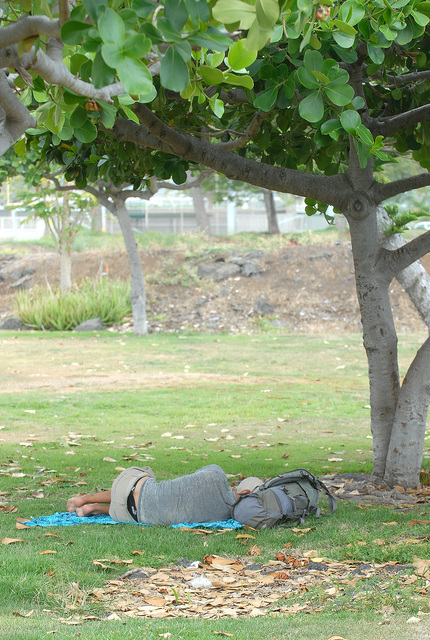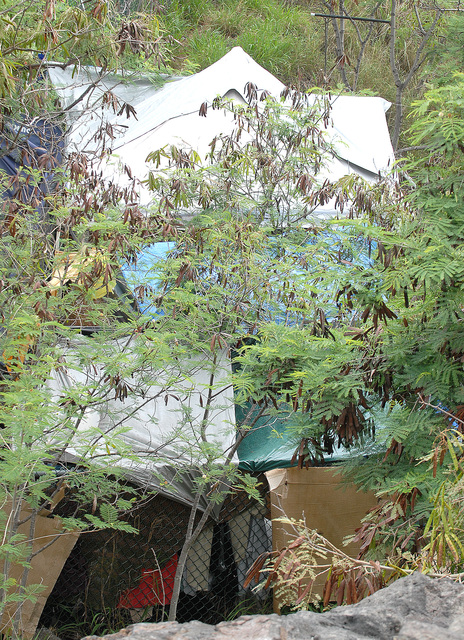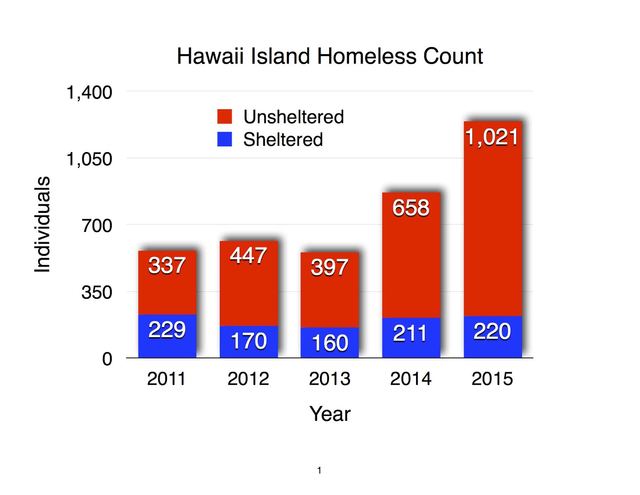Hawaii County’s homeless population has exploded in the last year, adding more new individuals than the rest of the state combined. ADVERTISING Hawaii County’s homeless population has exploded in the last year, adding more new individuals than the rest of
Hawaii County’s homeless population has exploded in the last year, adding more new individuals than the rest of the state combined.
In a count conducted statewide on Jan. 25, the state Department of Human Services logged 1,021 homeless individuals without shelter on the Big Island, and an additional 220 that were being housed either through emergency shelters or transitional housing programs.
The island’s total homeless count of 1,241 individuals for 2015 represents a nearly 43 percent increase over last year alone, and a 123 percent increase over 2013, when the island total was 557 homeless.
Hawaii County’s numbers are all the more striking when compared to the rest of the state. While Hawaii County added 372 new homeless in 2015, Oahu, which has a total population nearly five times bigger than the Big Island’s, added only 191. That represents a mere 4 percent increase, bringing the island’s total to 4,903.
Maui added 178 new homeless, and Kauai saw a 10 percent decrease of 39 people to a total of 339.
Ka‘u saw the biggest jump on the Big Island, with a nearly 90 percent increase in its homeless population, adding 104 new people to bring its total to 220. Other large growth areas on the island include:
• Pahoa, adding 87 homeless, for a total of 187;
• Hilo, adding 64 homeless, for a total of 203;
• Kealakehe, adding 55 homeless, for a total of 236;
• Honokaa, adding 53 homeless, for a total of 64, representing an increase of more than 480 percent.
Clarysse Nunokawa, executive assistant to Hawaii County Mayor Billy Kenoi, said that among her duties, she works to facilitate a countywide task force charged with helping to address homelessness. In recent years, that job has gotten more challenging, she said.
“It really is increasing,” she said. “It’s a real challenge. There are no easy answers, no silver bullet. It’s really going to take all of us working together.”
As for where all these new homeless residents are coming from and why, Nunokawa said those are questions that are very hard to answer.
“You hear things that we have not been able to validate,” she said. “Some say they’re coming from the mainland, from Honolulu. … There’s all kinds of urban legends. But we haven’t been able to verify any of that. … When you ask folks, you just really don’t know. It’s hard to know.”
County Councilwoman Valerie Poindexter, who represents the Hamakua Coast and portions of Hilo and Waimea, said that she believes that much of the increase in homelessness can be attributed to funding cuts for various programs addressing mental health, addiction and housing.
“Everything connects,” she said. “When you talk about homelessness, you also have to talk about substance abuse, because one thing leads to another.”
She added that Hawaii County in particular has seen a huge surge in the number of homeless being allowed by property owners to camp on their agricultural lots.
“You see it all over the place, just driving up Hamakua,” she said. “They’re allowing people to come in and set up tents on the property, or makeshift buildings with tarps on them.”
Councilman Aaron Chung, who represents a portion of South Hilo, said Thursday that Hawaii Island’s generally higher poverty levels likely played a big role in the homeless surge.
“There has to be a correlation between the homeless population and our poverty level,” he said. “The Big Island leads the state in poverty, and it has for a while. But there’s more to it than that. This is something that I’ve really been trying to talk to as many people as I can about this matter.”
In addition to the visible changes to downtown Hilo, Chung said many of Hawaii Island’s homeless are “invisible.”
“There is a hidden component we don’t see, living in cars, old buses. Also in remote areas,” he said. “It’s not just about the most visible ones. … This is such a complex problem.”
Nunokawa cautioned that because the data released by the state represents a one-time count — known as a “point-in-time count” and taking place on a single day each year — differences between years can sometimes not be reliable.
“There’s no doubt homelessness is increasing, but our counts have also gotten a little more accurate now, I think,” she said.
As the homeless population has climbed, the need for more housing and more mental-health services has become apparent, she added.
“We want to make sure people get the services they need,” Nunokawa said.
In addition to providing estimates for the numbers of sheltered and unsheltered homeless, the count allows service providers to accurately assess levels of homelessness for various household types, assess the number of chronically homeless individuals and families, and evaluate the extent of homelessness among veterans and youth.
Email Colin M. Stewart at cstewart@hawaiitribune-herald.com.






